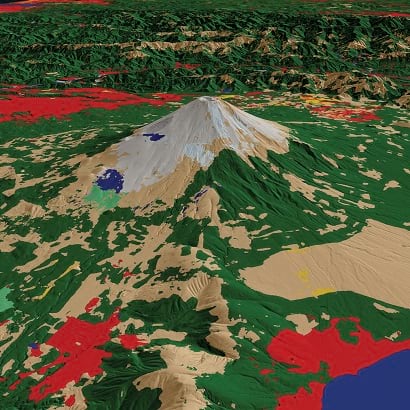A new book from Esri Press is being published and released this summer: The Power of Where, by Jack Dangermond, Esri, and the GIS Community. The book tells the story of the new GIS through authoritative text and hundreds of stunning visuals. It describes how the global GIS community is tackling a host of issues at scales from local to global, including planet-spanning challenges such as climate, biodiversity, poverty, health, and social justice.
Jack Dangermond and Esri are cited as authors for their work describing the methods, practices, and case studies of GIS throughout the book. Most important, though, is the third author, the GIS Community. They’re the people who have invested countless hours compiling and sharing data with other GIS organizations worldwide. They’re the people who have built communities, developed new concepts, and explored new frontiers in geographic data and analysis advancing the geographic approach. Modern GIS as we know it today could not exist without the data-sharing ethic and the collaborative spirit of cooperation adopted early on by GIS users everywhere – users who continue to openly share their data and ideas.

I did not write this book alone. Rather, it has been assembled with the help of my colleagues across Esri and the GIS user community. It represents many of the latest concepts behind modern GIS and the revolution it has created in thinking, action, and technology. Our collective aspiration is to share what we have learned and what we believe is a powerful way to better understand Earth’s systems and guide human action.
The book was inspired by Jack’s vision for GIS, and it both articulates his thinking about the geographic approach and expresses his passion for continuing to push the evolution of GIS forward. His vision and Esri’s fundamental work, keep advancing, sharpened in part by our conversations with GIS professionals. The work they perform in turn, inspires thousands of Esri employees to join him in working hard to meet their needs. The book is his latest contribution to this community and its wonderful work.

For those of us at Esri, it has been an honor to witness and observe the accomplishments throughout the history of GIS that have occurred through the critically important innovation and data sharing by the global GIS community. In response to this, The Power of Where is about user stories and examples. The book helps to define and describe the broadening power and roles of GIS: its movement to the web, its ever-broadening audience of users, its use as a tool that can be used to envision, plan, and implement a brighter future.
The book contains 490 GIS maps packed into 300 pages. Over 90 percent of these maps contain information layers from multiple GIS organizations. GIS data layers possess the wonderful property of being able to be georeferenced and combined with other overlapping GIS data and imagery layers. Often, this integration leads to new and unforeseen insights.

At Esri, we have had the unique opportunity to observe and help to guide this community ethic, created and nurtured by GIS users throughout our history. All of us, as members of this very special community, have built our individual accomplishments on mutual access to each other’s data and an open sharing of ideas. That spirit has been foundational to our collective success, and in the future, it will fuel the GIS community’s growing impact on the world.
We hope this book inspires you with new insights about the importance of your work.
To learn more about the book and to purchase your own copy, visit the Esri Press book page.
By the Core Book Team: Clint Brown, Christian Harder, Emily Meriam, Mark Henry, Victoria Roberts, and Allen Carroll
Article Discussion: